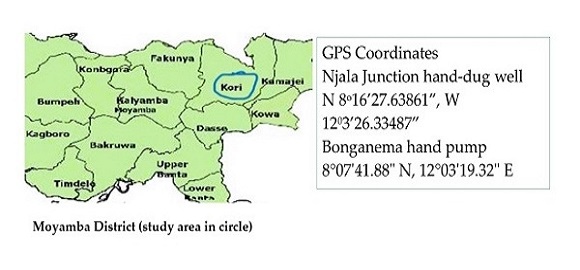Research Article
Mohamed Pujeh Junior*
Mohamed Pujeh Junior*
Corresponding Author
Department
of Chemistry, School of Basic Sciences, Njala University, Sierra Leone.
E-mail: mohamedpujehjunior@gmail.com, Tel: ++232 (78) 500738
Ishmael Kargbo
Ishmael Kargbo
Department
of Chemistry, School of Basic Sciences, Njala University, Sierra Leone.
Sallu Pujeh
Sallu Pujeh
Faculty
of Engineering and Physical Sciences, University of Surrey, United Kingdom.
Yahaya Kudush Kawa
Yahaya Kudush Kawa
Department
of Chemistry, School of Basic Sciences, Njala University, Sierra Leone.
Abstract
This study delves into the physicochemical and bacteriological characteristics of the Bonganema hand-pump and the Njala Junction hand-dug well, both vital sources of water for drinking and domestic purposes in the Kori Chiefdom of southern Sierra Leone. We meticulously analyzed a range of physicochemical parameters, including pH, electrical conductivity (EC), turbidity, total dissolved solids (TDS), and concentrations of sodium (Na mg/L), magnesium (Mg mg/L), calcium (Ca mg/L), iron (Fe mg/L), zinc (Zn mg/L), and copper (Cu mg/L). Additionally, we assessed crucial microbiological factors, focusing on both faecal and non-faecal coliforms. The water samples were transported to the Environmental Management and Quality Control Laboratory at Njala University, where they underwent rigorous analysis. The findings were then compared with the guidelines established by the World Health Organization (WHO), ensuring a thorough understanding of water quality and safety in this important region. The physical parameters of both the hand-pump and hand-dug well were under within the WHO guidelines. However, the hand-pump exhibited a concerning turbidity level of 8.46 NTU, significantly surpassing the WHO standard for drinking water turbidity of less than 5.0 NTU. While the chemical parameters for both sources remained within acceptable limits, the iron content raised alarms: the hand-pump recorded 0.67 mg/L, and the hand-dug well measured 2.817 mg/L, both well above the WHO’s permissible threshold of less than 0.3 mg/L. The bacteriological analysis of the hand-pump revealed alarming levels of faecal coliform at 16.67 and non-faecal coliform at 15.00, both of which surpassed the World Health Organization (WHO) safety limits. Likewise, the hand-dug well-presented even more concerning figures, with faecal coliform levels at 30.67 and non-faecal coliform at 28.67. Moreover, every water sample assessed demonstrated disturbingly high concentrations of NTUs, iron (Fe), faecal coliform, and non-faecal coliform, all far exceeding the WHO limits. As a result, this water is unequivocally deemed unfit for drinking and other domestic uses, underscoring the urgent need for intervention and improvement in water safety.
Keywords
Njala, WHO, samples, microbial, faecal coliform.
References
1.
Giordano, M. “Global groundwater? Issues
and solutions,” Ann. Rev. Environ. Resour. 34, 153–178, 2009, https://doi.org/10.1146/annurev.environ.030308.100251
2.
Brain, R.; Cronk, R.; Hossain, R.;
Bonjour, B.; Onda, K.; Wright, J.; Yang, H.; Slaymaker, T.; Hunter, P.;
Pruss-Ustun, A.; Bartram, J. Global
assessment of exposure to faecal contamination through drinking water based on
a systematic review. Trop. Med. Int. Health. 19(8), 917–927, 2014. https://doi.org/10.1111/tmi.12334
3.
Edori, O.S.; Iyama, W.; Simeon, O.;
Azuka, W.; and Amadi, M.Q.C. Variation of some physicochemical parameters in surface
water of Elelenwo river, Rivers State, Niger Delta, Nigeria. Int. J. Res. Sci.
Innov. 7(5), 230-235, 2020.
4.
Solomon, R.J.; Kehinde, O.A.
Physicochemical properties of a flowing stream in Jabi, Abuja, Nigeria. J.
Biosci. Biotechnol. Discov. 2(3), 29–35. 2017. https://doi.org/10.31248/JBBD2017.035
5.
Banunle, A.; Fei-Baffoe, B.; Otchere,
K.G. Determination of the physico-chemical properties and heavy metal status of
the tano river along the catchment of the Ahafo mine in the Brong-Ahafo region
of Ghana. J. Environ. Annal. Toxicol. 2018. 8(3), 1000574
6.
Edori, O.S.; Nna, P.J. Determination of physicochemical
parameters of effluents at discharge points into the new Calabar River along
Rumuolumeni Axis, Port Harcourt, Rivers State, Niger Delta, Nigeria. J. Environ.
Anal. Toxicol. 2018, 8(05), 1000585.
7.
Edeki, P.E.; Isah, E.C.; Mokogwu, N. Assessment
of physicochemical and bacteriological quality of drinking water in Sapele
local government area of Delta State, South-South, Nigeria. J. Water Health, 2023, 21(2), 286–298. https://doi.org/10.2166/wh.2023.246
8.
Takal, J.K.; Quaye-Ballard, J.A.
Bacteriological contamination of groundwater in relation to septic tanks location
in Ashanti Region, Ghana. Cogent Environ. Sci. 2018, 4(1), https://doi.org/10.1080/23311843.2018.1556197
9. DWAF. Quality of domestic water supplies. Sampling Guide 2. Department of Water Affairs and Forestry, Department of Health and Water Research Commission, 1999.
10. World Health Organization (WHO, 2003). Guidelines for drinking-water quality, 2nd Edn. Vol. 2. Health criteria and other supporting information. World Health Organization, Geneva, 1996.
This work is licensed under the
Creative Commons Attribution
4.0
License (CC BY-NC 4.0).
Abstract
This study delves into the physicochemical and bacteriological characteristics of the Bonganema hand-pump and the Njala Junction hand-dug well, both vital sources of water for drinking and domestic purposes in the Kori Chiefdom of southern Sierra Leone. We meticulously analyzed a range of physicochemical parameters, including pH, electrical conductivity (EC), turbidity, total dissolved solids (TDS), and concentrations of sodium (Na mg/L), magnesium (Mg mg/L), calcium (Ca mg/L), iron (Fe mg/L), zinc (Zn mg/L), and copper (Cu mg/L). Additionally, we assessed crucial microbiological factors, focusing on both faecal and non-faecal coliforms. The water samples were transported to the Environmental Management and Quality Control Laboratory at Njala University, where they underwent rigorous analysis. The findings were then compared with the guidelines established by the World Health Organization (WHO), ensuring a thorough understanding of water quality and safety in this important region. The physical parameters of both the hand-pump and hand-dug well were under within the WHO guidelines. However, the hand-pump exhibited a concerning turbidity level of 8.46 NTU, significantly surpassing the WHO standard for drinking water turbidity of less than 5.0 NTU. While the chemical parameters for both sources remained within acceptable limits, the iron content raised alarms: the hand-pump recorded 0.67 mg/L, and the hand-dug well measured 2.817 mg/L, both well above the WHO’s permissible threshold of less than 0.3 mg/L. The bacteriological analysis of the hand-pump revealed alarming levels of faecal coliform at 16.67 and non-faecal coliform at 15.00, both of which surpassed the World Health Organization (WHO) safety limits. Likewise, the hand-dug well-presented even more concerning figures, with faecal coliform levels at 30.67 and non-faecal coliform at 28.67. Moreover, every water sample assessed demonstrated disturbingly high concentrations of NTUs, iron (Fe), faecal coliform, and non-faecal coliform, all far exceeding the WHO limits. As a result, this water is unequivocally deemed unfit for drinking and other domestic uses, underscoring the urgent need for intervention and improvement in water safety.
Abstract Keywords
Njala, WHO, samples, microbial, faecal coliform.
This work is licensed under the
Creative Commons Attribution
4.0
License (CC BY-NC 4.0).

Editor-in-Chief
This work is licensed under the
Creative Commons Attribution 4.0
License.(CC BY-NC 4.0).


